Think Globally, Act Locally: Global Requirements and Local Transformation in Sugar Pots Manufacture in Sicily in the Medieval and Post-Medieval Periods
Abstract
:1. Introduction
2. Materials
3. Methods
3.1. Theoretical Framework
3.2. Analytical Approach
4. Results
4.1. Macroscopic Examination, Chemical, Mineral-Petrological, and Microstructural Results
4.2. Mechanical and Thermal Properties
4.2.1. Heat Transfer Properties
4.2.2. Fracture Strength
5. Discussion
5.1. Sugar Pots Production Areas and Circulation
5.2. Sugar Cones Material Properties across Phases and Contexts
5.3. Sugar Pots in the Context of Ceramic Manufacture in Sicily in the Medieval and Post-Medieval Phases
5.4. One Function, Multiple Choices
6. Conclusions
Supplementary Materials
Author Contributions
Funding
Data Availability Statement
Acknowledgments
Conflicts of Interest
References
- Robertson, R. Glocalization: Time-space and homogeneity-heterogeneity. Glob. Mod. 1995, 2, 25–44. [Google Scholar]
- Horden, P.; Purcell, N. The Corrupting Sea: A Study of Mediterranean History; Blackwell: Oxford, UK, 2000. [Google Scholar]
- Broodbank, C. The Making of the Middle Sea: A History of the Mediterranean from the Beginning to the Emergence of the Classical World; Thames & Hudson: London, UK, 2013. [Google Scholar]
- Mintz, S.W. Sweetness and Power. In The Place of Sugar in Modern History; Penguin: New York, NY, USA, 1986; pp. 48–52. [Google Scholar]
- Galloway, J.H. The Mediterranean Sugar Industry. Geogr. Rev. 1977, 67, 177–194. [Google Scholar] [CrossRef]
- Watson, A. The Arab Agricultural Revolution and Its Diffusion, 700–1100. J. Econ. Hist. 1974, 34, 8–35. [Google Scholar] [CrossRef]
- Decker, M. Plants and Progress: Rethinking the Islamic Agricultural Revolution. J. World Hist. 2009, 20, 187–206. [Google Scholar] [CrossRef]
- Squatriti, P. Of Seeds, Seasons, and Seas: Andrew Watson’s Medieval Agrarian Revolution Forty Years Later. J. Econ. Hist. 2014, 74, 1205–1220. [Google Scholar] [CrossRef]
- Fuks, D.; Amichay, O.; Weiss, E. Innovation or preservation? Abbasid aubergines, archaeobotany, and the Islamic Green Revolution. Archaeol. Anthr. Sci. 2020, 12, 50. [Google Scholar] [CrossRef]
- Berthier, P. Les Anciennes Sucreries du Maroc et Leurs Réseaux Hydrauliques: Étude Archéologique et D’histoire Économique; Impr. Française et Marocaines: Rabat, Morocco, 1966. [Google Scholar]
- Abulafia, D. Sugar in Spain. Eur. Rev. 2008, 16, 191–210. [Google Scholar] [CrossRef]
- Politis, K.D. (Ed.) Origins of the Sugar Industry and the Transmission of Ancient Greek and Medieval Arab Science and Technology from the Near East to Europe. In Proceedings of the International Conference Athens 23 May 2015; National and Kapodistriako: Athens, Greece, 2015. [Google Scholar]
- Jones, R.E. Sweet Waste: A View from the Mediterranean and from the 2002 Excavations at the Tawahin es-Sukkar (Safi), Jordan; Potingair Press: Glasgow, UK, 2017. [Google Scholar]
- Bronstein, J.; Stern, E.J.; Yehuda, E. Franks, locals and sugar cane: A case study of cultural interaction in the latin kingdom of Jerusalem. J. Mediev. Hist. 2019, 45, 316–330. [Google Scholar] [CrossRef]
- Shapiro, A.; Stern, E.J.; Getzov, N.; Waksman, S.Y. Ceramic Evidence for Sugar Production in the ‘Akko Plain: Typology and Provenance Studie. In Multidisciplinary Approaches to Food and Foodways in the Medieval Eastern Mediterranean; Waksman, S.Y., Ed.; Archéologie(s) 4, MOM Ėditions: Lyon, France, 2020; pp. 163–189. [Google Scholar]
- Tullio, A. Mentesana et al. forthcoming. Archaeological evidences of Medieval Sugar Production in Sicily: A Reassessment. 2022; Submitted for publication. [Google Scholar]
- Banqueri, J.A. Ibn al-‘Awwām, Libro de Agricultura; García Sánchez, E., Hernández Bermejo, J.E., de Ministerio, A.P.A., de Ministerio, A.A., Eds.; EE: Madrid, Spain, 1988; Volume 2. [Google Scholar]
- Ouerfelli, M. Le Sucre. Production, Commercialisation et Usages Dans la Méditerranée Médiévale; Brill: Leyde-Boston, MA, USA, 2008. [Google Scholar]
- Hein, A.; Müller, N.S.; Day, P.M.; Kilikoglou, V. Thermal Conductivity of Archaeological Ceramics: The effect of Inclusions, Porosity and Firing Temperature. Thermochim. Acta 2008, 480, 35–42. [Google Scholar] [CrossRef]
- Müller, N.S.; Kilikoglou, V.; Day, P.M.; Vekinis, G. The influence of temper shape on the mechanical properties of archaeological ceramics. J. Eur. Ceram. Soc. 2010, 30, 2457–2465. [Google Scholar] [CrossRef]
- Müller, N.S.; Vekinis, G.; Day, P.M.; Kilikoglou, V. The influence of microstructure and texture on the mechanical properties of rock tempered archaeological ceramics. J. Eur. Ceram. Soc. 2015, 35, 831–843. [Google Scholar] [CrossRef]
- Kilikoglou, V.; Vekinis, G.; Maniatis, Y.; Day, P.M. Mechanical Performance of Quartz Tempered Ceramics: Part I, Strength and Toughness. Archaeometry 1998, 40, 261–279. [Google Scholar] [CrossRef]
- Müller, N.S. Mechanical and Thermal Properties. In The Oxford Handbook of Archaeological Ceramic Analysis; Hunt, A., Ed.; Oxford University Press: Oxford, UK, 2016; pp. 602–624. [Google Scholar]
- Kilikoglou, V.; Vekinis, G. Failure Prediction and Function Determination of Archaeological Pottery by Finite Element Analysis. J. Archaeol. Sci. 2002, 29, 1317–1325. [Google Scholar] [CrossRef]
- Hein, A.; Kilikoglou, V. Breaking Pots–Simulating design failures of transport amphorae by using the finite element method (FEM). In Archaeological Research in the Digital Age. Proceedings of the 1st Conference on Computer Applications and Quantitative Methods in Archaeology Greek Chapter (CAA-GR), Rethymno, Greece, 6–8 March 2014; Papadopoulos, C., Paliou, E., Chrysanthi, A., Kotoula, E., Sarris, A., Eds.; Institute for Mediterranean Studies–Foundation of Research and Technology (IMS-Forth): Rethymno, Greece, 2015; pp. 187–190. [Google Scholar]
- Sillar, B.; Tite, M.S. The Challenge of ‘Technological Choices’ for Materials Science Approaches in Archaeology. Archaeometry 2000, 42, 2–20. [Google Scholar] [CrossRef]
- Morreale, A. Insula Dulcis: L’industria Della Canna da Zucchero in Sicilia; Edizioni Scientifiche Italiane: Napoli, Italy, 2006; Volume 8. [Google Scholar]
- Trasselli, C. Storia Dello Zucchero Siciliano; Sciascia ed.: Caltanissetta-Roma, Italy, 1982. [Google Scholar]
- Bresc, H. Un Monde Méditerranéen: Economie et Société en Sicile 1300–1450; Accademia di Scienze, Lettere e Arti di Palermo ed.: Palermo, Italy, 1986. [Google Scholar]
- Tullio, A. Strumenti per la lavorazione dello zucchero a Maredolce. Archeol. Territ. 1997, 471–479. [Google Scholar]
- Tullio, A. L’indagine Archeolologica (2000–2001); Complesso di Maredolce: Roma, Italy, 2002; pp. 661–667. [Google Scholar]
- Tusa, V. Scavi medioevali a Palermo. Sicil. Archeol. 1973, 23, 57–61. [Google Scholar]
- Falsone, G. Forme e cantarelli: I vasi per la raffinazione dello zucchero alla luce dei recenti rinvenimenti dello Steri. Sicil. Archeol. 1974, 24–25, 103–112. [Google Scholar]
- Falsone, G. Gli scavi del 1973. Sequenza cronologica e culturale. In Lo Steri dei Chiaromonte a Palermo; Lima, M.I., Ed.; Plumelia ed.: Palermo, Italy, 2015; pp. 420–435. [Google Scholar]
- Lo Cascio, P. Due trappeti della cannamela dell’area palermitana. Sicil. Archeol. 2002, XXXV, 35–71. [Google Scholar]
- Bonacasa, N. I Saggi di Scavo. In Himera 2. Campagne di Scavo 1966–1973; Allegro, N., Belvedere, O., Bonacasa, N., Bonacasa-Carra, R.M., Epifanio, E., di Stefano, C., Elda, A.J., Manni-Piraino, M.T., Schmiedt, G., Tullio, A., et al., Eds.; L’Erma di Bretschneider: Roma, Italy, 1976; pp. 627–664. [Google Scholar]
- Vassallo, S. Scavi della Soprintendenza Beni Culturali di Palermo nella città bassa e nelle necropoli di Himera. Kokalos 2017, LIV, 159–202. [Google Scholar]
- D’Angelo, F. “Forme” da zucchero e ceramiche invetriate dipinte “tipo Polizzi” della fine XV–inizio XVI secolo rinvenute a Buonfornello (comune di Termini Imerese). Not. Archeol. Soprintend. Palermo 2021, 130, 115x28. [Google Scholar]
- Mentesana, R.B. Medieval sugar pots from Sicily: Archaeological, typological and morphometric data. Repos. Dades Recer. 2022. [Google Scholar] [CrossRef]
- Montana, G.; Caruso, A.; Lavore, A.T.; Polito, A.M.; Sulli, A. Definizione Composizionale Delle “Argille Ceramiche” Presenti Nella Sicilia Nord-Occidentale: Inquadramento Geologico E Ricadute Di Carattere Archeometrico. Il Quat. 2006, 19, 279–298. [Google Scholar]
- Montana, G.; Polito, A.M.; Sulli, A. Le «Argille Ceramiche» Sicilia Occidentale e Centrale; IlionBooks: Enna, Italy, 2011. [Google Scholar]
- Dunnell, R.C. Evolutionary theory and archaeology. Adv. Archaeol. Method Theory 1980, 3, 35–99. [Google Scholar]
- Neff, H. Ceramics and evolution. In Archaeological Method and Theory, 4; Schiffer, M.B., Ed.; University of Arizona Press: Tucson, AZ, USA, 1992; pp. 141–193. [Google Scholar]
- Neff, H. Theory, sampling, and technical studies in archaeological pottery analysis. Am. Antiq. 1993, 58, 23–44. [Google Scholar] [CrossRef]
- O’Brien, M.J.; Holland, T.D.; Hoard, R.J.; Fox, G.L. Evolutionary implications of design and performance characteristics of prehistoric pottery. J. Archaeol. Method Theory 1994, 1, 259–304. [Google Scholar] [CrossRef]
- Leonard, R.D. Evolutionary Archaeology. In Archaeological Theory Today; Hodder, I., Ed.; Blackwell Publishers: Oxford, UK, 2001; pp. 65–97. [Google Scholar]
- Hodder, I. Entangled: An Archaeology of the Relationships between Humans and Things; John Wiley and Sons: Hoboken, NJ, USA, 2012. [Google Scholar]
- Steponaitis, V.P. Technological studies of prehistoric pottery from Alabama: Physical properties and vessel function. In The Many Dimensions of Pottery; van der Leeuw, S.E., Pritchard, A.C., Eds.; University of Amsterdam: Amsterdam, The Netherlands, 1984; pp. 79–127. [Google Scholar]
- Bronitsky, G.; Hamer, R. Experiments in Ceramic Technology: The Effects of Various Tempering Materials on Impact and Thermal-Shock Resistance. Am. Antiq. 1986, 51, 89–101. [Google Scholar] [CrossRef]
- Manem, S. Modeling the Evolution of Ceramic Traditions through a Phylogenetic Analysis of the Chaînes Opératoires: The European Bronze Age as a Case Study. J. Archaeol. Method Theory 2020, 27, 992–1039. [Google Scholar] [CrossRef]
- Buxeda i Garrigós, J.; Madrid i Fernández, M.M. Designing Rigorous Research: Integrating Science and Archaeology. In The Oxford Handbook of Archaeological Ceramic Analysis; Hunt, A.M.W., Ed.; Oxford University Press: Oxford, UK, 2016; pp. 19–47. [Google Scholar]
- Lemonnier, P. Introduction. In Technological Choices: Transformations in Material Cultures Since the Neolithic; Lemonnier, P., Ed.; Routledge: London, UK, 1993; pp. 1–35. [Google Scholar]
- Jones, A. Archaeological Theory and Scientific Practice; Cambridge University Press: Cambridge, UK, 2004. [Google Scholar]
- Day, P.M. Technology and Ethnography in Petrographic Studies of Ceramics. In Archaeometry: Proceedings of the 25th International Symposium (Athens, Greece 1986); Maniatis, Y., Ed.; Elsevier: Amsterdam, The Netherlands, 1989; pp. 138–147. [Google Scholar]
- Hilditch, J. Reconstruction of Technological Choice, Social Practice and Networks of Exchange from a Ceramic Perspective in the Middle Bronze Age Cyclades. Ph.D. Thesis, University of Exeter, Exeter, UK, 2008. [Google Scholar]
- Mentesana, R. The Final Neolithic-Early Bronze Age Transition in Phaistos, Crete: An Investigation of the Continuity and Change in Pottery Manufacture. Ph.D. Thesis, University of Sheffield, Sheffield, UK, 2016. Available online: https://etheses.whiterose.ac.uk/15354/ (accessed on 1 February 2022).
- Cresswell, R. Transferts de techniques et chaînes opératoires. Tech. Cult. 1983, 2, 143–163. [Google Scholar] [CrossRef] [Green Version]
- Roux, V. Anthropological interpretation of ceramic assemblages: Foundations and implementations of technological analysis. In Archaeological Ceramics: A Review of Current Research; Scarcella, S., Ed.; BAR International Series 2193; Archaeopress: Oxford, UK, 2011; pp. 80–88. [Google Scholar]
- Bourdieu, P. Outline of a Theory of Practice; Cambridge University Press: Cambridge, UK, 1977. [Google Scholar]
- Bourdieu, P. Distinction: A Social Critique of the Judgment of Taste; Harvard University Press: Harvard, MA, USA, 1984. [Google Scholar]
- Lave, J.; Wenger, E. Situated Learning: Legitimate Peripheral Participation; Cambridge University Press: Cambridge, UK, 1991. [Google Scholar]
- Wenger, E. Communities of Practice: Learning, Meaning and Identity; Cambridge University Press: Cambridge, UK, 1998. [Google Scholar]
- Roux, V. Des Céramiques et des Hommes: Décoder les Assemblages Archéologiques; Presses Universitaires de Paris Ouest: Paris, France, 2016. [Google Scholar]
- Maggetti, M. Phase Analysis and Its Significance for Technology and Origin. In Archaeological Ceramics; Olin, J.S., Franklin, A.D., Eds.; Smithsonian Institution Press: Washington, WA, USA, 1982; pp. 121–133. [Google Scholar]
- Tite, M.S.; Freestone, I.C.; Meeks, N.D.; Bimson, M. The use of scanning electron microscopy in the technological examination of ancient ceramics. In Archaeological Ceramics; Olin, J.S., Franklin, A.D., Eds.; Smithsonian Institution Press: Washington, WA, USA, 1982; pp. 109–120. [Google Scholar]
- Madrid i Fernández, M.; Sinner, A.G. Analysing technical choices: Improving the archaeological classification of Late Republican Black Gloss pottery in north-eastern Hispania consumption centres. Archaeol. Anthropol. Sci. 2019, 11, 3155–3186. [Google Scholar] [CrossRef]
- Buxeda i Garrigós, J. Alteration and Contamination of Archaeological Ceramics: The Perturbation Problem. J. Archaeol. Sci. 1999, 26, 295–313. [Google Scholar] [CrossRef] [Green Version]
- Whitbread, I.K. A Proposal for the Systematic Description of Thin Sections towards the Study of the Ancient Ceramic Technology. In Archaeometry: Proceedings of the 25th International Symposium (Athens, Greece 1986); Maniatis, Y., Ed.; Elsevier: Amsterdam, The Netherlands, 1989; pp. 127–138. [Google Scholar]
- Whitbread, I.K. Appendix III. In Greek Transport Amphorae: A Petrological and Archaeological Study; Whitbread, I.K., Ed.; British School at Athens: London, UK, 1995. [Google Scholar]
- Whitbread, I.K. Fabric Description of Archaeological Ceramics. In the Oxford Handbook of Archaeological Ceramic Analysis; Hunt, A., Ed.; Oxford University Press: Oxford, UK, 2016; pp. 199–216. [Google Scholar]
- Log, T.; Gustafsson, S.E. Transient plane source (TPS) technique for measuring thermal transport properties of building materials. Fire Mater. 1995, 19, 43–49. [Google Scholar] [CrossRef]
- Shetty, D.K.; Rosenfield, A.R.; Duckworth, W.H.; Held, P.R. A Biaxial Flexure Test for Evaluating Ceramic Strengths. J. Am. Ceram. Soc. 1983, 66, 36–42. [Google Scholar] [CrossRef]
- Shetty, D.K.; Rosenfield, A.R.; McGuire, P.; Bansal, G.K.; Duckworth, W.H. Biaxial Flexure Tests for Ceramics. Am. Ceram. Soc. Bull. 1980, 59, 1193–1197. [Google Scholar]
- Morrell, R. Biaxial Flexural Strength Testing of Ceramic Materials, Measurement Good Practice Guide No. 12.; Middlesex: National Physical Laboratory: Teddington, UK, 1998. [Google Scholar]
- Catalano, R.; Basilone, L.; Di Maggio, C.; Gasparo Morticelli, M.; Agate, M.; Avellone, G. Note Illustrative Della Carta Geologica D’Italia alla Scala 1:50.000, Foglio 594–585; Partinico–Mondello: Ispra, Italy, 2013. [Google Scholar]
- Cau Ontiveros, M.A.; Day, P.M.; Montana, G. Secondary calcite in archaeological ceramics: Evaluation of alteration and contamination processes by thin section study. In Modern Trends in Scientific Studies on Ancient Ceramics. Papers presented at the 5th European Meeting on Ancient Ceramics, Athens 1999; Kilikoglou, V., Hein, A., Maniatis, Y., Eds.; BAR International Series: 1011; Archaeopress: Oxford, UK, 2002; pp. 9–18. [Google Scholar]
- Polizzi, G.; Ducati, F. Fornaci e produzioni del Golfo di Castellammare (Sicilia nord-occidentale)’, Mélanges de l’École française de Rome. Antiq. Open Ed. 2020, 132, 403–428. [Google Scholar] [CrossRef]
- Mentesana, R.B.; Buxeda i Garrigós, J.; Madrid i Fernández, M. Medieval sugar pots from Sicily: Chemical data. Repos. Dades Recer. 2022. [Google Scholar] [CrossRef]
- Egozcue, J.J.; Pawlowsky-Glahn, V. Basic concepts and procedures. In Compositional Data Analysis; Pawlowsky-Glahn, V., Buccianti, A., Eds.; Theory and Applications; Wiley: Chichester, UK, 2011; pp. 12–28. [Google Scholar]
- Martín-Fernández, J.A.; Buxeda i Garrigós, J.; Pawlowsky-Glahn, V. Logratio Analysis in Archaeometry: Principles and Methods. In Mathematics and Archaeology; Barceló, J.A., Bogdanovic, I., Eds.; CRC Press: Boca Ratón, FL, USA, 2015; pp. 178–189. [Google Scholar]
- Buxeda i Garrigós, J. Compositional Data Analysis. In The Encyclopedia of Archaeological Sciences; Varela, S.L.L., Ed.; John Wiley & Sons: Oxford, UK, 2018; pp. 1–5. [Google Scholar]
- R Core Team. R: A Language and Environment for Statistical Computing; R Foundation for Statistical Computing: Vienna, Austria, 2021; Available online: http://www.R-project.org/ (accessed on 1 February 2022).
- Aitchison, J. The Statistical Analysis of Compositional Data; Monographs on Statistics and Applied Probability; Chapman and Hall: London, UK, 1986. [Google Scholar]
- Buxeda i Garrigós, J.; Kilikoglou, V. Total variation as a measure of variability in chemical data sets. In Patterns and Process: A Festschrift in Honor of Dr. Edward V; Sayre. van Zelst, L., Ed.; Smithsonian Center for Materials Research and Education: Washington, DC, USA, 2003; pp. 185–198. [Google Scholar]
- Shannon, C.E. A mathematical theory of communication. Bell Syst. Tech. J. 1948, 27, 379–423. [Google Scholar] [CrossRef] [Green Version]
- Aitchison, J.; Greenacre, M. Biplots of compositional data, applied statistics. J. R. Stat. Soc. Ser. C 2002, 51, 375–392. [Google Scholar] [CrossRef] [Green Version]
- Greenacre, M. Biplots in Practice, BBVA Foundation Manuals; Fundación BBVA: Bilbao, Spain, 2010. [Google Scholar]
- van de Boogaart, K.G.; Tolosana-Delgado, R. Analysing Compositional Data with R; Springer: Berlin/Heidelberg, Germany, 2013. [Google Scholar]
- i Garrigós, J.B.; Fernández, M.M.; Gurt i Esaparraguera, J.M. Provinença i Tecnologia de les Ceràmiques de “Pisa” i d”Obra de Manises” del Dipòsit de la Plaça Gran de Mataró. In La Ceràmica Catalana del Segle XVII Trobada a la Plaça Gran (Mataró); Mellado, J.A.C.i., Ed.; Associació Catalana de Ceràmica Decorada i Terrissa: Barcelona, Spain, 2001; pp. 155–170. [Google Scholar]
- Iñañez, J.G. Caracterització Arqueomètrica de la Ceràmica Vidrada Decorada de la Baixa Edat Mitjana al Renaixement dels Principals Centres Productors de la Península Ibèrica. Ph.D. Thesis, Universitat de Barcelona, Barcelona, Spain, 2007. Available online: http://hdl.handle.net/10803/2596 (accessed on 1 February 2022).
- Mentesana, R.B. Medieval sugar pots from Sicily: Petrographic photomicrographs. Repos. Dades Recer. 2022. [Google Scholar] [CrossRef]
- Heimann, R.B.; Maggetti, M. Ancient and Historical Ceramics. Materials, Technology, Art, and Culinary Traditions; Schweizerbart Science Publishers: Stuttgart, Germany, 2014. [Google Scholar]
- Maniatis, Y.; Tite, M.S. Technological examination of Neolithic- Bronze Age pottery from Central and Southeast Europe and from the Near East. J. Archaeol. Sci. 1981, 8, 59–76. [Google Scholar] [CrossRef]
- Mentesana, R.B.; Buxeda i Garrigós, J.; Madrid i Fernández, M. Medieval sugar pots from Sicily: Mineralogical data. Repos. Dades Recer. 2022. [Google Scholar] [CrossRef]
- Mentesana, R.B.; Buxeda i Garrigós, J.; Madrid i Fernández, M. Medieval sugar pots from Sicily: Microstructural data. Repos. Dades Recer. 2022. [Google Scholar] [CrossRef]
- Whitney, D.L.; Evans, B.W. Abbreviations for names of rock-forming minerals. Am. Mineral. 2010, 95, 185–187. [Google Scholar] [CrossRef]
- Lemoine, C.; Poupet, P.; Barrandon, J.N.; Borderie, B.; Meille, E. Étude de quelques altérations de composition chimique des céramiques en milieu marin et terrestre. Rev. D’Archéométrie 1981, 1, 349–360. [Google Scholar] [CrossRef]
- Maritan, L. Ceramic abandonment. How to recognise post-depositional transformations. Archaeol. Anthropol. Sci. 2020, 12, 199. [Google Scholar] [CrossRef]
- Béarat, H.; Dufournier, D.; Nouet, Y. Alterations of ceramics due to contact with seawater. Archaeol. Pol. 1992, 30, 151–162. [Google Scholar]
- Amadori, M.L.; Baldassari, R.; Lanza, S.; Maione, M.; Penna, A.; Acquaro, E. Archaeometric study of Punic amphorae from the underwater recoveries of Pantelleria Island (Sicily). Rev. Archéométrie 2002, 26, 79–91. [Google Scholar] [CrossRef]
- Buxeda i Garrigós, J.; Madrid i Fernández, M. Sobre un Individu de Ceràmica Grisa Monocroma del Derelicte de Cala Sant Vicenç i la Seva Contrastació Amb la Producció de la Palaià Polis D’Empúries: La Seva Caracterització Arqueomètrica. In El Vaixell Grec Arcac de Cala Sant Vicenç; Nieto, X., Santos, M., Eds.; Monografies del CASC, 7; Museu d’Arqueologia de Catalunya-Barcelona/Centre de Cultura Contemporània de Barcelona: Barcelona, Spain, 2008; pp. 347–354. [Google Scholar]
- Buxeda i Garrigós, J.; Tsantini, E. Les Àmfores Ibèriques del Derelicte de Cala Sant Vicenç i la Seva Contrastació Amb les Àmfores de la Palaia Polis d’Empúries. Evidències des de la Seva Caracterització Arqueomètrica. In El Vaixell Grec Arcaic de Cala; de Cala, E.V.F., Vicenç, S., Nieto, X., Santos, M., Eds.; Monografies del CASC 7; Museu d’Arqueologia de Catalunya-Barcelona/Centre de Cultura Contemporània de Barcelona: Barcelona, Spain, 2008; pp. 373–395. [Google Scholar]
- Buxeda i Garrigós, J.; Cau Ontiveros, M.A.; Madrid, M.; Toniolo, A. Roman Amphorae from the Iulia Felix Shipwreck: Alteration and Provenance. In Proceedings of the 33rd International Symposium on Archaeometry, Amsterdam, The Netherlands, 22–26 April 2002; Hars, H., Burke, E., Eds.; Institute for Geo-and Bioarchaeology of the Vrije Universiteit in Amsterdam: Amsterdam, The Netherlands, 2005; pp. 149–151. [Google Scholar]
- Buxeda i Garrigós, J.; Ferreras, V.M.; Socias, L.V. Caracterització arqueomètrica de les àmfores Pascual 1 del derelicte Culip VIII. In Culip VIII i les àmfores Haltern 70; Carreras, C., Aguilera, A., Berni, P., Garrote, E., Marimón, P., Morais, R., Moros, J., Nieto, X., Puig, A., Remesal, J., et al., Eds.; Monografies del CASC 5: Girona, Spain, 2005; pp. 167–188. [Google Scholar]
- Pradell, T.; Vendrell-Saz, M.; Krumbein, W.; Picon, M. Altérations de céramiques en millieu marin: Les amphores de l’épave romaine de la Madrague de Giens (Var). Rev. Archéométrie 1996, 20, 47–56. [Google Scholar] [CrossRef]
- Hein, A.; Mentesana, R.B.; Kilikoglou, V. Medieval sugar pots from Sicily: Mechanical and thermal properties test data. Repos. Dades Recer. 2022. [Google Scholar] [CrossRef]
- Hein, A.; Day, P.M.; Quinn, P.S.; Kilikoglou, V. The geochemical diversity of Neogene clay deposits in Crete and its implications for provenance studies of Minoan pottery. Archaeometry 2004, 46, 357–384. [Google Scholar] [CrossRef]
- Canzonieri, E.; Vassallo, S. Insediamenti Extraurbani A Palermo: Nuovi Dati Da Maredolce. In Les Dynamiques de L’islamisation en Méditerranée Centrale et en Sicile: Nouvelles Propositions et Découvertes Récentes; Nef, A., Ardizzone, F., Eds.; Edipuglia: Roma-Bari, Italy, 2014; pp. 271–277. [Google Scholar]
- Matson, F.R. The study of temperatures used in firing ancient Mesopotamian pottery. In Science and Archaeology; Brill, R., Ed.; The Massachusetts Institute of Technology Press: Cambridge, MA, USA, 1971; pp. 65–79. [Google Scholar]
- Testolini, V. Ceramic Technology and Cultural Change in Sicily from the 6th to the 11th Century AD. Ph.D. Thesis, University of Sheffield, Sheffield, UK, 2018. [Google Scholar]
- Rye, O.S. Pottery Technology. In Principles and Reconstruction; Taraxacum: Washington, DC, USA, 1981. [Google Scholar]
- Alaimo, R.; Giarrusso, R.; Montana, G.G. Indagini mineralogiche e petrografiche su materiale ceramico proveniente dal palazzo medievale della Zisa. Mélanges L’école Française Rome Moyen-Âge 1999, 111, 45–50. [Google Scholar]
- Giarrusso, R.; Mulone, A. L’analisi dei Materiali. In Les bains de Cefalà (Cefalà Diana, prov. de Palerme): La Campagne de Fouilles de Septiembre 2006; Bagnera, A., di Liberto, R., Nef, A., Pezzini, E., Eds.; Mélanges de L’école Française de Rome; Edipuglia: Roma-Bari, Italy, 2007; pp. 493–517. [Google Scholar]
- Giarrusso, R.; Mulone, A. Caratterizzazione Mineralogico-Petrografica di Campioni Ceramici Provenienti da Castello–S. Pietro, Dalla Chiesa Della Gancia (Palermo) e da Castello Della Pietra (Castelvetrano). In Les Dynamiques de L’islamisation en Méditerranée Centrale et en Sicile; Nef, A., Ardizzone, F., Eds.; Collection de L’école Française de Rome; Edipuglia: Roma-Bari, Italy, 2014; pp. 191–195. [Google Scholar]
- Gioia, C.; D’Angelo, F. Analisi minero-petrografiche sui reperti dello scarico di fornaci di Palazzo Lungarini a Palermo (fine XI-inizio XII secolo). Archeol. Mediev. 2007, 34, 337–343. [Google Scholar]
- Alaimo, R.; Giarusso, R. Indagini Mineralogiche Petrografiche su Materiale Ceramico Medievale Rinvenuto a Palermo in Via Torremuzza. In La Ceramica Altomedievale in Italia. Atti del V Congresso di Archeologia Medievale, Roma, 2001; Uggeri, S.P., Ed.; All’Insegna del Giglio: Firenze, Italy, 2004; pp. 372–374. [Google Scholar]
- D’Angelo, F. Influenze Straniere Nella Ceramica Medievale di Palermo. In Atti del VI Convegno Internazionale della Ceramica; Centro Ligure per la Storia Della Ceramica: Albisola, Italy, 1976; pp. 107–116. [Google Scholar]
- D’Angelo, F. Maestranze e processi produttivi nei quartieri della Palermo Medievale (Sec. XI–XIV). Not. Archeol. Soprintend. Palermo 2016, 10, 1–12. [Google Scholar]
- Battaglia, G.; Canzonieri, E. Fornaci e Scarichi di età Islamica alla Stazione Centrale e Presso Porta Sant’Agata (Palermo). In La Città che Produce: Archeologia della Produzione Negli Spazi Urbani: Atti delle Giornate Gregoriane, X Edizione (10–11 December 2016); Caminneci, V., Parello, M.C., Rizzo, M.S., Eds.; Edipuglia: Bari, Italy, 2018; pp. 215–222. [Google Scholar]
- Pezzini, E. Questioni sulle produzioni ceramiche palermitane tra fine XII e XIV secolo: Un confronto tra fonti scritte e dato ceramico. Arch. Stor. Per La Sicil. Orient. IV 2020, 1, 28–37. [Google Scholar] [CrossRef]
- Termotto, R. Una industria zuccheriera del Cinquecento: Galbinogara. Mediterr. Ric. Stor. 2005, 3, 45–74. [Google Scholar]
- Termotto, R. Contratti di lavoro e migrazioni stagionali nell’industria zuccheriera siciliana. Mediterr. Ric. Stor. 2012, 25, 253–284. [Google Scholar]
- Alaimo, R.; Giarrusso, R.; Iliopoulos, I.; Montana, G. Coppe Tipo Iato K480: Indagini Archeometriche Finalizzate Alla Individuazione del Centro di Produzione. In Atti del Io Congresso Nazionale di Archeometria; Martini, M., D’Amico, C., Fassani, L., Garagnani, G.L., Improta, S., Milazzo, M., Sabbioni, F.P.C., Eds.; Verona, Dicembre 1999; Pàtron Editore: Bologna, Italy, 2000; pp. 413–425. [Google Scholar]
- Montana, G.; Randazzo, L.; Bechtold, B. The Beginning of Western Greek Amphorae Production in Western Sicily: Archaeometric and Archaeological Studies on 6th–5th Centuries BCE Amphorae Manufactured in Himera. Minerals 2020, 10, 762. [Google Scholar] [CrossRef]
- D’Angelo, F.; Gioia, C.; Reginella, M. La Ceramica Ingobbiata, Invetriata e Dipinta del XV Secolo di Polizzi (PA). In Atti del XLIV Convegno Internazionale della Ceramica; Centro Ligure per la Storia della Ceramica: Albisola, Italy, 2012; pp. 313–323. [Google Scholar]

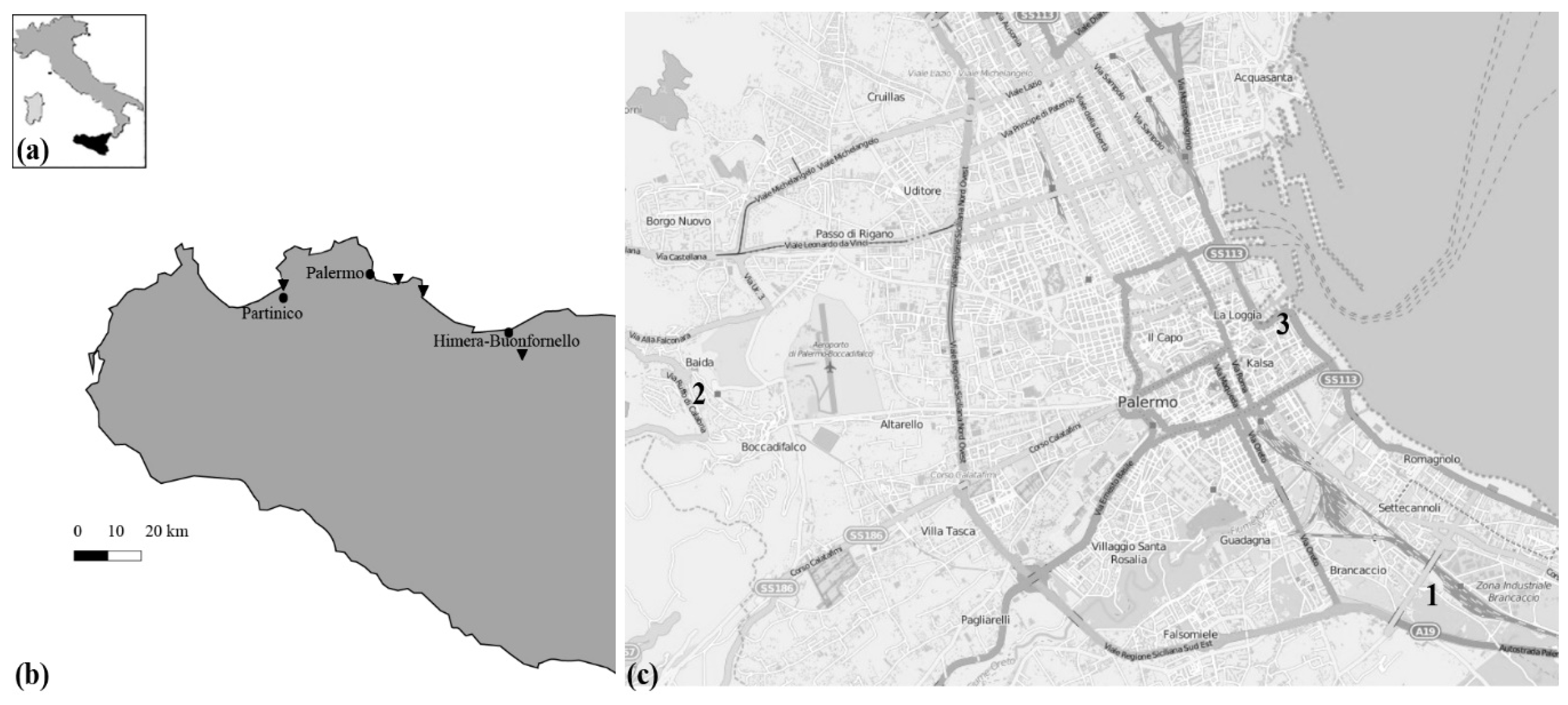


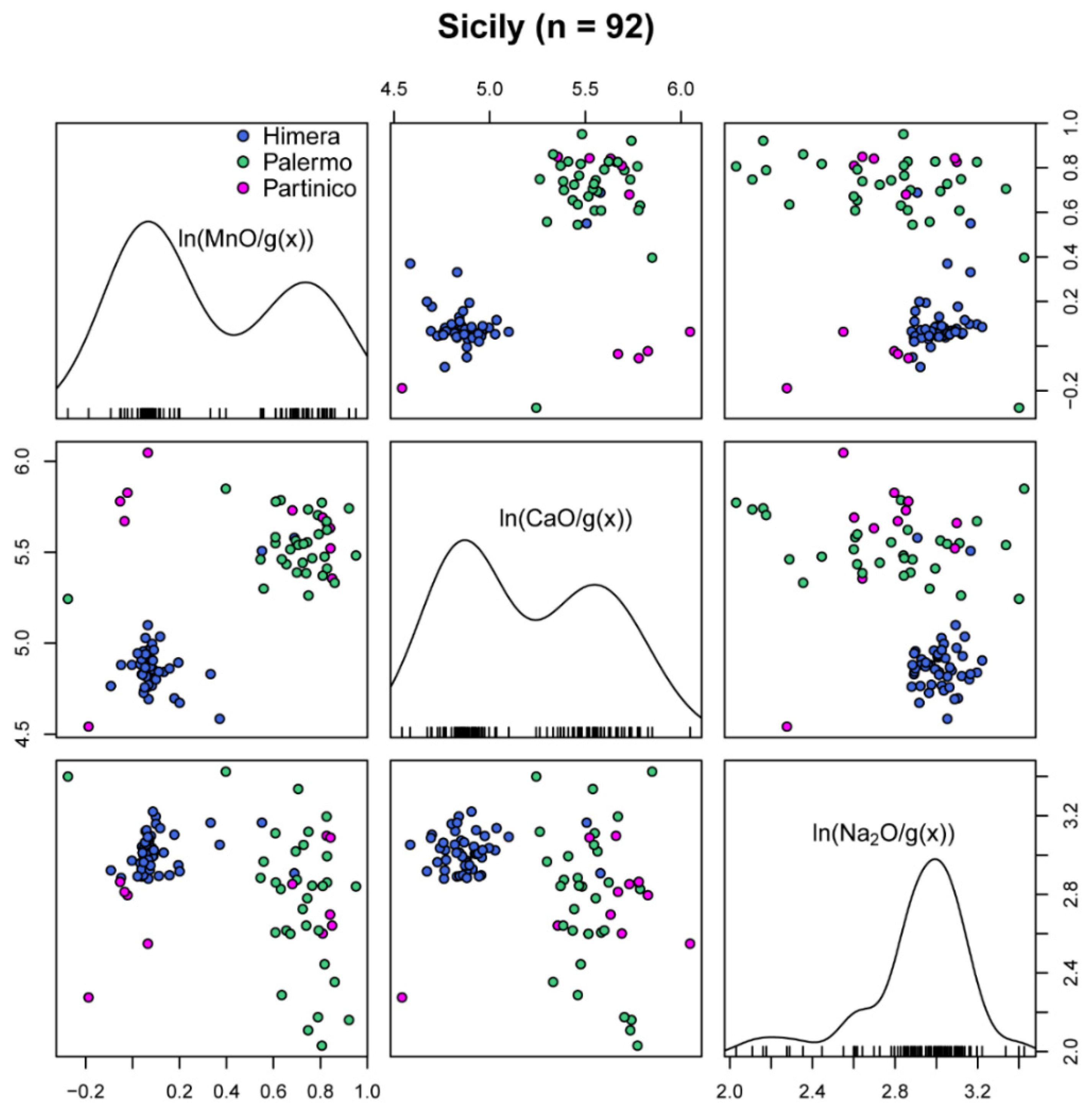



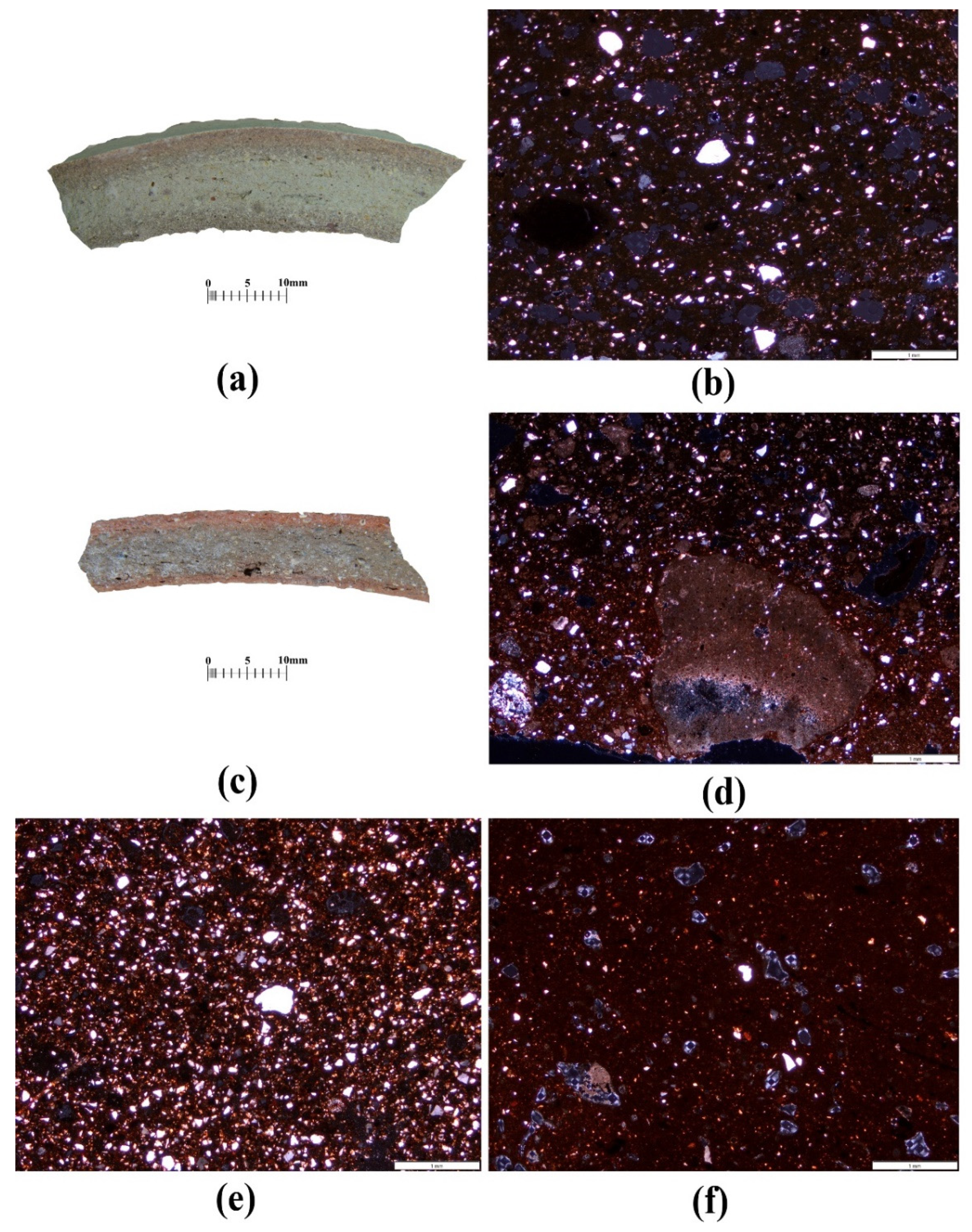



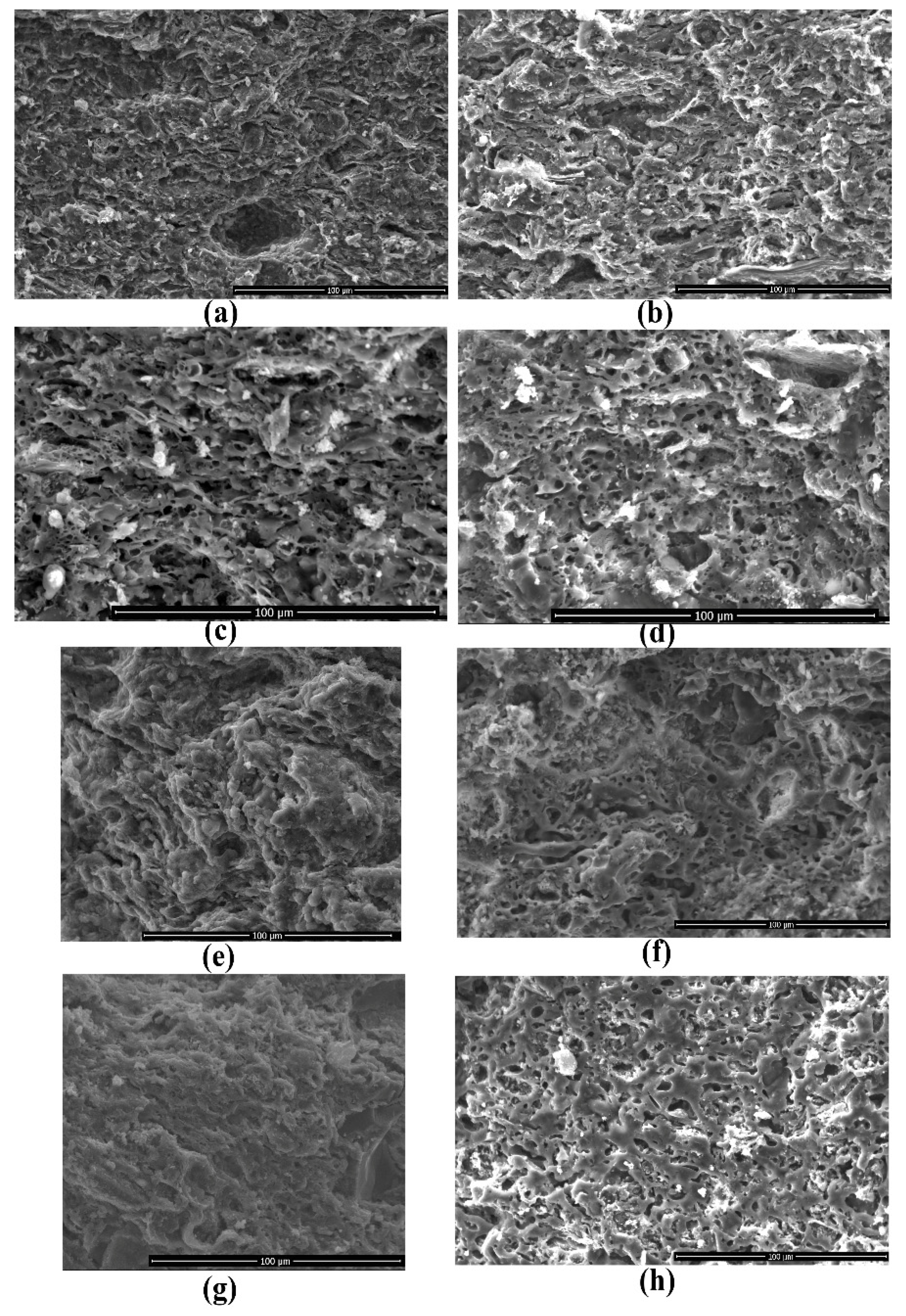

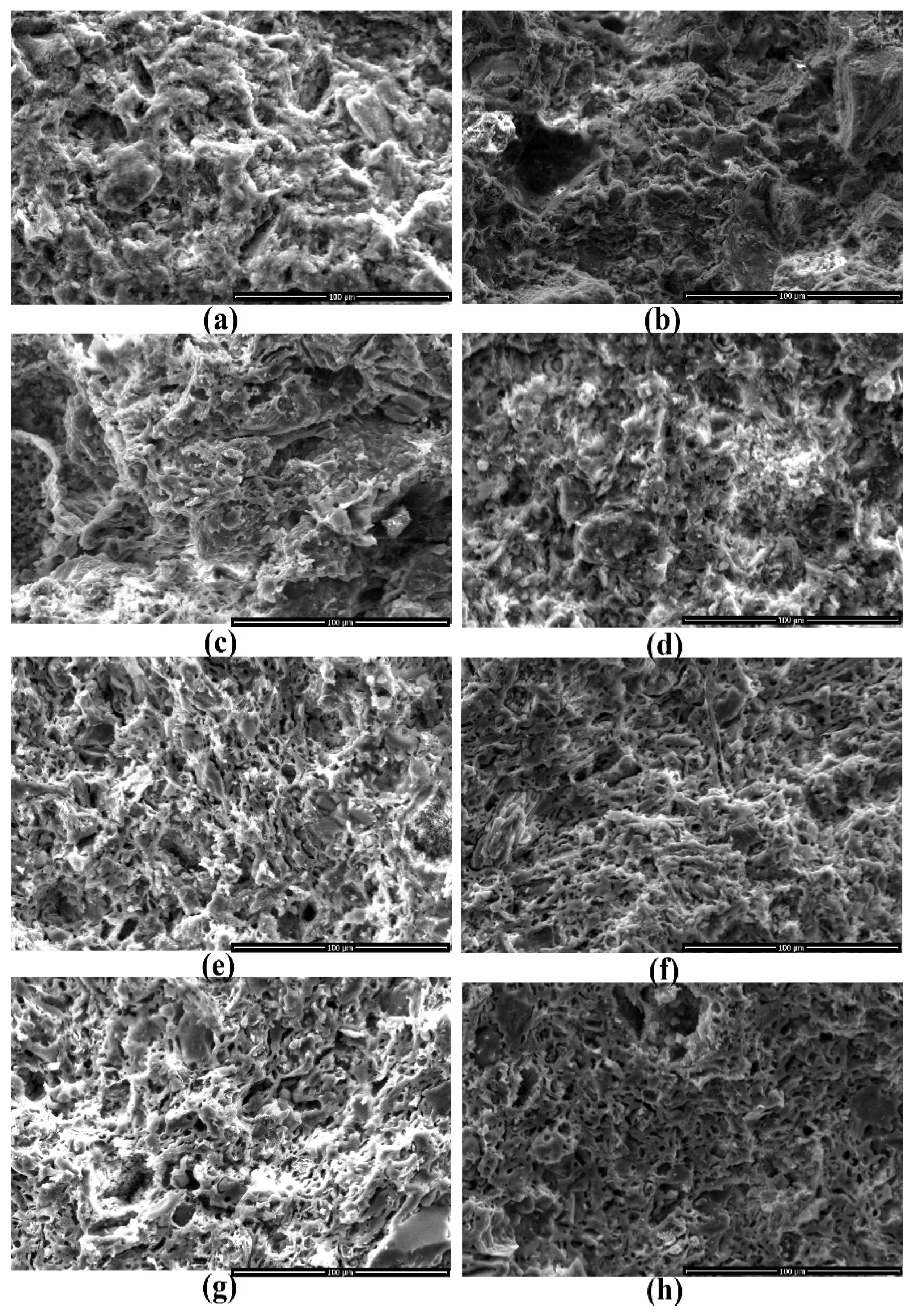
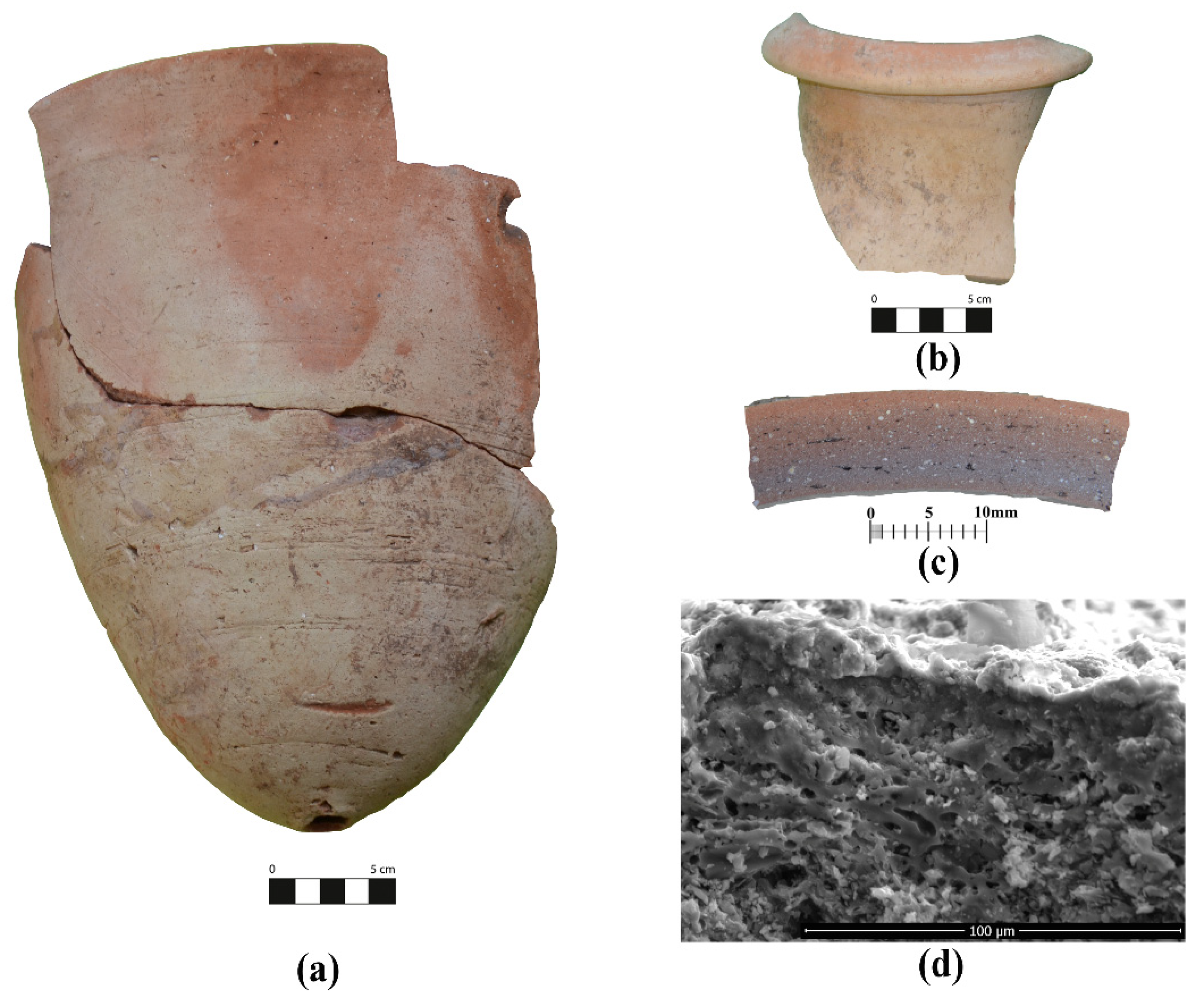
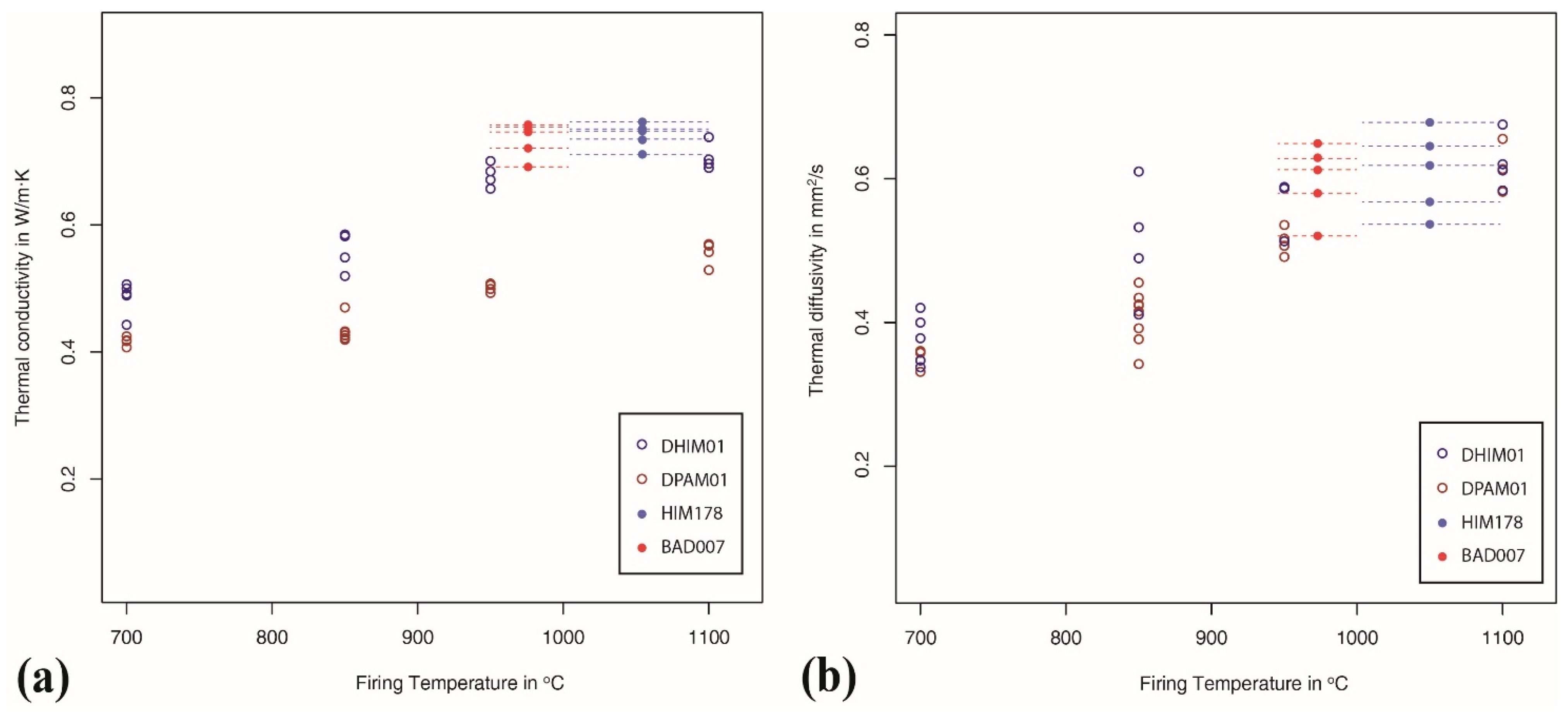
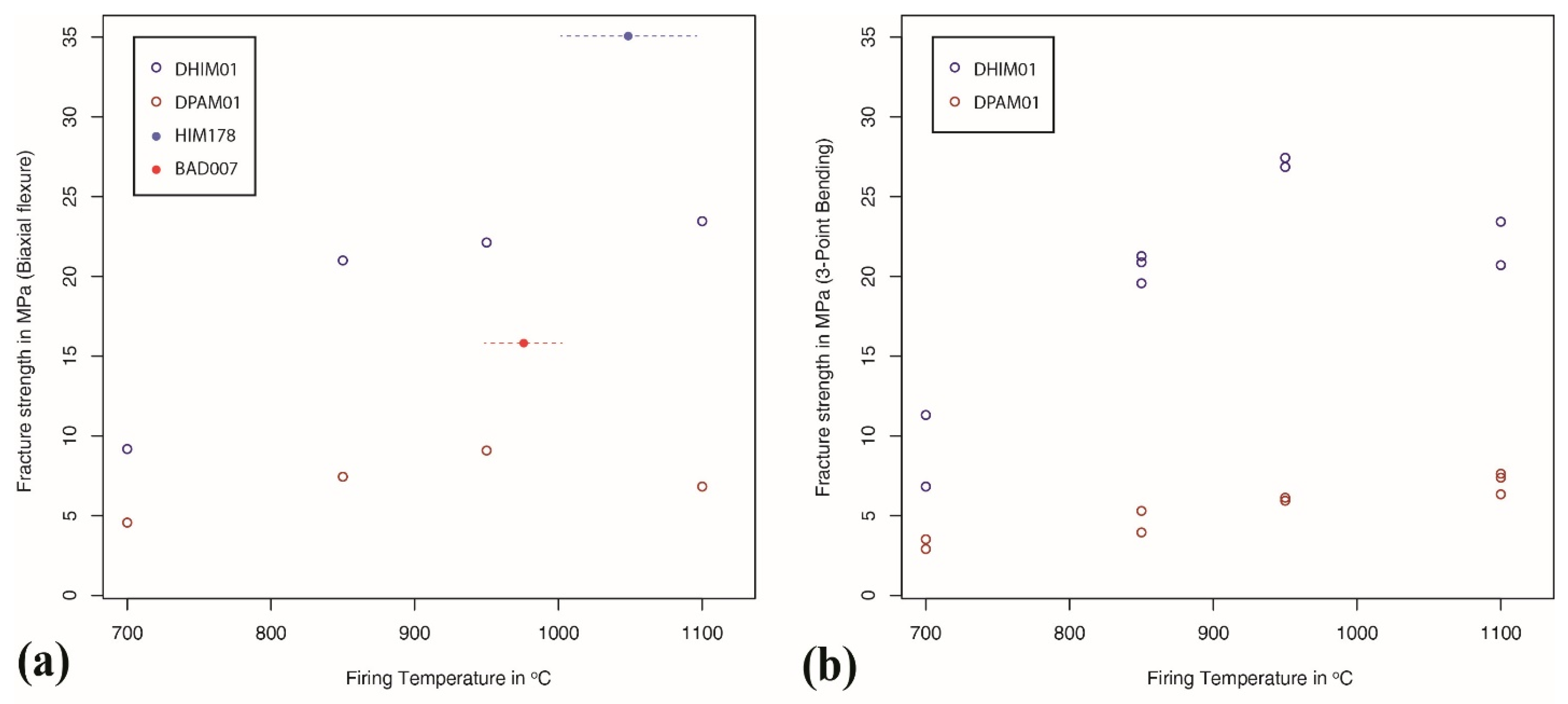
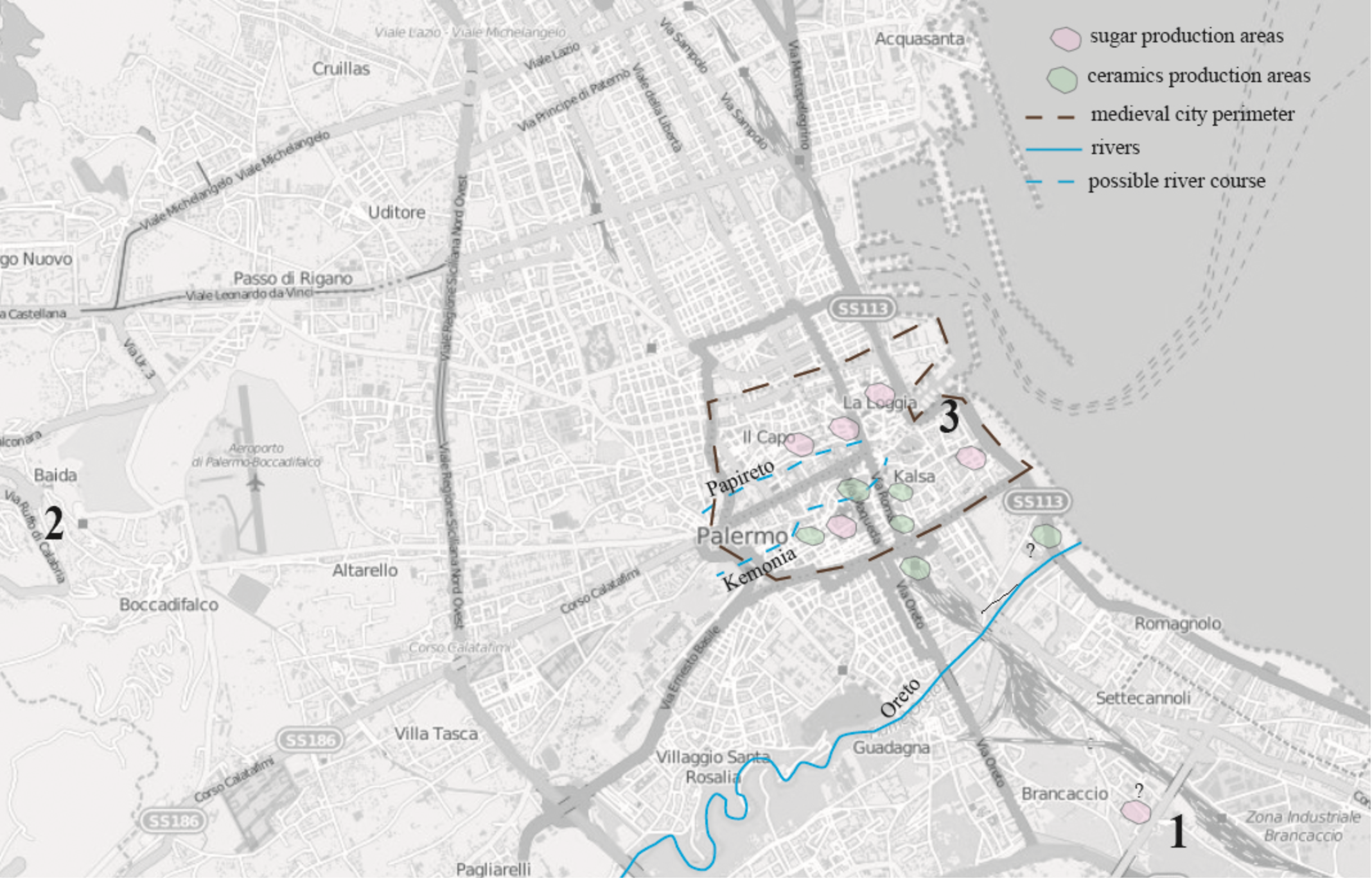
| Site | Vessel Shape | Tot. Site | ||
|---|---|---|---|---|
| Molasses Jar | Sugar Cone | Others | ||
| Underwater, Palermo (UND) | 1 | 1 | ||
| sampled | 1 | 1 | ||
| Castello della Favara in Maredolce, Palermo (MAR) | 2 | 8 | 10 | |
| sampled | 2 | 8 | 10 | |
| Convento di Baida, Palermo (BAD) | 7 | 7 | ||
| sampled | 5 | 5 | ||
| Palazzo Steri–Chiaramonte, Palermo (STE) | 5 | 7 | 7 | 19 |
| sampled | 2 | 7 | 5 | 14 |
| San Giovanni degli Eremiti? (PAM) | 1 | 1 | ||
| sampled | 0 | 0 | ||
| Himera–Buonfornello (HIM) | 50 | 126 | 176 | |
| sampled | 19 | 34 | 53 | |
| Partinico (PAR) | 3 | 8 | 11 | |
| sampled | 3 | 7 | 10 | |
| Tot. studied | 60 | 156 | 7 | 225 |
| Tot. sampled | 26 | 62 | 5 | 93 |
| ID | Location | Geological Formation |
|---|---|---|
| DHIM01 | Collesano (PA) 37°57′48.8″ N 13°50′58.8″ E | Terravecchia |
| DPAM01 | Ficarazzi (PA), 38°05′44.1″ N 13°27′23.3″ E | Ficarazzi |
| DPAM02 | Santa Flavia (PA) 38°04′53.1″ N 13°32′14.1″ E | Ficarazzi |
| DPAR01 | Baia di San Cataldo, cala dei Muletti (PA), 38°05′06.0″ N 13°05′02.0″ E | Numidian flysch |
| DPAR01 | DPAM02 | DPAM01 | UND001 | CGPAR01 (n = 4) | CGPAL01 (n = 6) | CGPAL02 (n = 31) | CGHIM01 (n = 47) | |||||
|---|---|---|---|---|---|---|---|---|---|---|---|---|
| s | s | s | s | |||||||||
| Na2O | 0.48 | 1.6 | 1.25 | 1.19 | 0.73 | 0.13 | 0.46 | 0.08 | 0.88 | 0.2 | 1.16 | 0.11 |
| MgO | 1.99 | 2.14 | 1.24 | 6.28 | 2.18 | 0.06 | 2.33 | 0.19 | 1.87 | 0.28 | 2.66 | 0.17 |
| Al2O3 | 17.97 | 17.33 | 9.59 | 14.93 | 12.76 | 0.54 | 14.35 | 0.93 | 13.96 | 0.85 | 17.77 | 0.62 |
| SiO2 | 64.04 | 58.42 | 66.42 | 57.8 | 60.00 | 1.08 | 59.24 | 1.18 | 61.51 | 1.44 | 59.91 | 1.28 |
| K2O | 2.24 | 2.29 | 1.42 | 1.65 | 1.78 | 0.16 | 1.64 | 0.11 | 1.73 | 0.31 | 2.92 | 0.30 |
| CaO | 4.61 | 10.1 | 14.13 | 10.17 | 15.79 | 1.83 | 14.18 | 1.57 | 12.62 | 1.5 | 7.37 | 0.79 |
| TiO2 | 0.97 | 0.93 | 0.64 | 0.85 | 0.72 | 0.03 | 0.81 | 0.04 | 0.79 | 0.05 | 0.90 | 0.03 |
| V | 147 | 143 | 87 | 100 | 101 | 7 | 96 | 5 | 86 | 6 | 134 | 9 |
| Cr | 125 | 121 | 88 | 89 | 81 | 11 | 87 | 4 | 83 | 8 | 125 | 7 |
| MnO | 0.04 | 0.04 | 0.06 | 0.11 | 0.05 | 0.00 | 0.11 | 0.01 | 0.10 | 0.01 | 0.06 | 0.01 |
| Fe2O3 | 7.52 | 7.00 | 5.13 | 6.88 | 5.85 | 0.29 | 6.74 | 0.38 | 6.39 | 0.37 | 7.08 | 0.21 |
| Ni | 39 | 35 | 20 | 42 | 30 | 2 | 40 | 2 | 37 | 4 | 49 | 3 |
| Zn | 91 | 88 | 52 | 78 | 70 | 6 | 78 | 3 | 96 | 27 | 104 | 4 |
| Ga | 21 | 19 | 9 | 14 | 13 | 1 | 14 | 1 | 13 | 2 | 22 | 1 |
| Rb | 108 | 101 | 62 | 62 | 68 | 5 | 73 | 2 | 71 | 10 | 124 | 7 |
| Sr | 181 | 344 | 348 | 290 | 340 | 18 | 312 | 57 | 274 | 37 | 322 | 29 |
| Y | 27 | 26 | 20 | 27 | 23 | 1 | 30 | 2 | 30 | 2 | 27 | 1 |
| Zr | 251 | 225 | 287 | 248 | 232 | 12 | 265 | 14 | 276 | 13 | 212 | 10 |
| Nb | 29 | 26 | 18 | 23 | 22 | 1 | 24 | 2 | 23 | 1 | 25 | 1 |
| Ba | 304 | 224 | 216 | 284 | 370 | 55 | 326 | 41 | 345 | 52 | 363 | 44 |
| Ce | 105 | 104 | 49 | 80 | 72 | 12 | 87 | 9 | 85 | 7 | 90 | 6 |
| Th | 15 | 15 | 11 | 14 | 14 | 1 | 16 | 1 | 14 | 1 | 16 | 1 |
| tv | 0.12 | 0.13 | 0.33 | 0.08 | ||||||||
| XRF Group | Petrographic Fabric | XRD Fabric | Individuals | Vitrification Stage Core/Margins | Calcareous/Low Calcareous | EFT °C |
|---|---|---|---|---|---|---|
| UND001 | PPAL01 | F1—Afs, Cal, Mg-Cal, Hem, Pl, Px, Qz, Spl | UND001 | / | low calc. | >950–1000 |
| CGHIM01 | PHIM01 | F1—Afs, Cal, Hem, Ilt, Pl, Qz | HIM001, 015, 070, 099, 121 | NV | calc. | <800 |
| F2—Cal, Px, Hem, Ilt, Gh, Pl, Qz | HIM036, 042, 044, 047, 080, 091, 098, 135, 142, 146, 158 | Vc | calc. | (850–950/1000) | ||
| F3—Afs, Di, Hem, Ilt (1-2/3), Gh, Pl, Qz | HIM013, 021, 035, 050, 075, 112, 148, 176, 177 | Vc+ | calc. | (950/1000) | ||
| F4—Afs, Cal, Gh, Px, Hem, Pl, Qz | HIM003,005, 007, 008, 018, 019, 023, 029, 031, 034, 045, 055, 056, 057, 060, 062, 071, 072, 082, 084, 092, 109, 113, 147, 167, 178 | TV | calc. | (1000–1100) | ||
| CGPAR01 | PPAR01 | F1—Cal, Ilt, Pl, Qz | PAR002, 003, 006, 009 | NV | calc. | <800 |
| CGPAL01 | PPAL01 | F1—Cal, Hem, Ilt (2/3), Gh, Pl, Qz | BAD001, 02, 006, 007 MAR008 | Vc | calc. | (950–1000) |
| F2—Cal, Px, Hem, Pl, Qz | MAR006 | TV | calc. | (1000–1100) | ||
| CGPAL02 | PPAL01 | F1—Cal, Ilt (1/3), Pl, Qz | STE011, 013, 014, PAR005 | NV/IV | calc. | 800 |
| F2—Cal, Ilt (1/3), Hem, Pl, Qz | STE003, MAR005, PAR004 | NV/IV | calc. | 800 | ||
| F3—Cal, Gh, Ilt (1/3), Hem, Pl, Qz | STE012, PAR007, 008, 010, 011 | V | calc. | (950–1000) | ||
| F4—Afs, Cal, Px, Gh, Ilt (1/3), Hem, Pl, Qz | STE001, 002, 005, 006, 008, 009, 016, BAD004, HIM174, 175 | TV | calc. | (1000–1100) | ||
| F5—Afs, Cal, Px Ilt (1/3), Hem, Pl, Qz | MAR009 MAR001, 004, 007, STE004 | TV | calc. | (1000–1100) | ||
| F6—Afs, Cal, Px, Hem, Pl, Qz | MAR003 and MAR010 | / | calc. | (1000–1100) | ||
| F7—Cal, Px, Hem, Pl, Qz, Gh | STE010 | TV | calc. | (1000–1100) | ||
| F8—Afs, Di, Pl, Qz | MAR002 | TV+ | calc. | (1000–1100) |
Publisher’s Note: MDPI stays neutral with regard to jurisdictional claims in published maps and institutional affiliations. |
© 2022 by the authors. Licensee MDPI, Basel, Switzerland. This article is an open access article distributed under the terms and conditions of the Creative Commons Attribution (CC BY) license (https://creativecommons.org/licenses/by/4.0/).
Share and Cite
Mentesana, R.; Hein, A.; Madrid i Fernàndez, M.; Kilikoglou, V.; Buxeda i Garrigós, J. Think Globally, Act Locally: Global Requirements and Local Transformation in Sugar Pots Manufacture in Sicily in the Medieval and Post-Medieval Periods. Minerals 2022, 12, 423. https://doi.org/10.3390/min12040423
Mentesana R, Hein A, Madrid i Fernàndez M, Kilikoglou V, Buxeda i Garrigós J. Think Globally, Act Locally: Global Requirements and Local Transformation in Sugar Pots Manufacture in Sicily in the Medieval and Post-Medieval Periods. Minerals. 2022; 12(4):423. https://doi.org/10.3390/min12040423
Chicago/Turabian StyleMentesana, Roberta, Anno Hein, Marisol Madrid i Fernàndez, Vassilis Kilikoglou, and Jaume Buxeda i Garrigós. 2022. "Think Globally, Act Locally: Global Requirements and Local Transformation in Sugar Pots Manufacture in Sicily in the Medieval and Post-Medieval Periods" Minerals 12, no. 4: 423. https://doi.org/10.3390/min12040423
APA StyleMentesana, R., Hein, A., Madrid i Fernàndez, M., Kilikoglou, V., & Buxeda i Garrigós, J. (2022). Think Globally, Act Locally: Global Requirements and Local Transformation in Sugar Pots Manufacture in Sicily in the Medieval and Post-Medieval Periods. Minerals, 12(4), 423. https://doi.org/10.3390/min12040423







